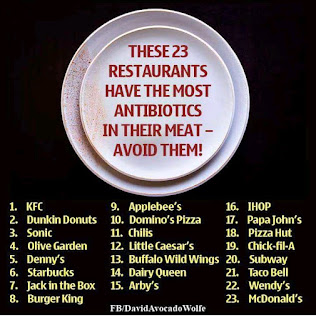23 restaurants to avoid. They have the most antibiotics in their meat
The subject of antibiotics in food is a serious one. The United Nations called the practice a global health crisis on par with AIDS. The overuse of antibiotics increases levels of drug-resistant bacteria, which according to the United Nations “will make providing high-quality universal healthcare coverage more difficult if not impossible.”
The past couple of years has seen some big-name chains making promises to discontinue use of antibiotic-treated meat. McDonald’s, for example has moved away from using poultry that had been treated with important human antibiotics starting last year. But this report reveals we still have a long way to go.
Here’s how 25 major chain restaurants ranked:
A: Chipotle, Panera Bread
B+: Subway
B: Chick-fil-A
B-: Taco Bell, KFC
C+: McDonald’s
C: Wendy’s
D+: Pizza Hut, Starbucks
D: Dunkin’ Donuts, Jack in the Box, Burger King, Papa John’s
As you can see, there are a lot of chains sitting at the bottom with an “F” grade. Restaurants received an “F” if they “have taken no discernible action to reduce use of antibiotics in their supply chains.”
Restaurants that got an “A” grade showed “exemplary policies and practices with respect to antibiotic use.” They both serve pork and beef, as well as poultry, raised without antibiotics.
Another thing the report pointed out was that while many restaurants have begun moving away from buying chicken that has been treated with important human antibiotics, there hasn’t been enough of a change when it comes to beef, pork or turkey.
Executive Summary
Background
The declining ability of antibiotics to cure diseases
they once easily vanquished is a growing public
health crisis. The Centers for Disease Control and
Prevention states that already, at least 23,000 people
die annually from antibiotic-resistant infections, and
the toll is likely to rise
To combat this trend and preserve the effectiveness
of antibiotics, we must use them less, so that
bacteria have less chance to develop immunity to
them. Doctors and hospitals must use antibiotics
more judiciously. However, some 70 percent of all
medically important antibiotics sold in the United
States are intended for use not in human medicine,
but in animal agriculture.
We must also drastically reduce use in animals, where antibiotics are often
used to promote growth and prevent disease in
industrial farming conditions.
The nation’s fast food restaurant chains are in a
unique position to address the antibiotic resistance
crisis. Fast food chains are huge buyers of meat and
poultry. A quarter of all chicken produced in the
United States is sold through fast food restaurants,
according to the National Chicken Council, and
McDonald’s has been cited in the media as the
largest buyer of beef in the United States.
Fast food restaurants can demand that their suppliers reduce
or eliminate antibiotic use in the production of the
meat and poultry they purchase.
A coalition of organizations, including Consumers
Union, Center for Food Safety, Food Animals
Concerns Trust, Friends of the Earth, Natural
Resources Defense Council and U.S. Public Interest
Research Group Education Fund, have called on the
nation’s largest fast food and fast casual restaurant
chains to adopt policies limiting antibiotic use in
their supply chains. This third annual Chain Reaction
Report assesses the restaurants’ progress.
Survey and Scorecard Results
The 2017 Chain Reaction III Report and Scorecard ranks America’s 25 largest fast food and fast casual restaurant chains on their antibiotics policies.
The 2017 Chain Reaction III Report and Scorecard ranks America’s 25 largest fast food and fast casual restaurant chains on their antibiotics policies.
The goal of this effort is to help consumers make
educated choices about the meat they eat, and
encourage the largest chains in these industries to
improve their sourcing policies.
Our 2017 survey results indicate that increasingly, fast
food companies are seeking to address the antibiotic
resistance public health crisis by mandating
changes in their supply chain. Fourteen of the top
25 companies, a clear majority, have taken at least
some steps to limit use of antibiotics in all or some of their supply chains. These fourteen, accounting
for two-thirds of all fast food industry revenue received passing grades, up from nine last year and
five the year before. The five companies that made
a commitment for the first time this year are KFC, Burger King, Starbucks, Dunkin’ Donuts and Jack in the Box.
It is important to note, however, that while remarkable progress has been made to reduce or even eliminate use of medically important antibiotics, this progress has largely occurred in chicken production. With a few exceptions, companies have made little progress in reducing the use of antibiotics in their pork and beef supplies. Only two companies, Chipotle and Panera, currently serve pork and beef, as well as poultry, raised without antibiotics. Both Chipotle and Panera continue to earn an “A” grade in the Scorecard for their exemplary policies and practices with respect to antibiotic use. Subway has adopted a policy that addresses antibiotic use in meat as well as poultry, but implementation in pork and beef is on a long timeline, earning it a “B+.”
KFC improved the most over last year, earning a “B-” compared to last year’s “F”, as a result of making a commitment to transition its entire product line, all chicken, to being raised without antibiotics important in human medicine by the end of 2018.Chick-fil-A, Taco Bell, and Wendy’s have also progressed in implementing their antibiotics commitments in chicken, earning grades in the “B” and “C” range. McDonald’s earned a “C+” this year, the same grade as in 2016, when it announced that all the chicken it served in the U.S. was raised without medically important antibiotics. It made no new commitments on beef or pork, however. In August 2017 McDonald’s published a new “Vision on Antibiotic Stewardship” document that established ambitious goals for limiting use of medically important antibiotics in its entire global supply chain for all of its meats. But time bound policies for pork and beef have not been established under this new vision.
One company, Pizza Hut, received a “D+” grade because it made a token effort, i.e., setting good antibiotics use policies on chicken, and implementing them, but applying them only to a small fraction of its chicken purchases. Starbucks, which made a time bound commitment for poultry, but not for beef and pork, also earned a D+. Three more major chains—Burger King, Jack in the Box, and Dunkin’ Donuts—adopted new policies limiting use of either medically important or all antibiotics in chicken for the first time this year. But they lacked implementation, transparency commitments and/ or
timebound commitments for beef and pork, earning
them “D”s. Papa John’s adopted a good policy, but
it only applies to a portion of its chicken and is not
verified by an independent auditor, so it also received
a “D.”
Unfortunately, 11 of the top 25 fast food chains,
including several “fast casual” restaurants like Olive
Garden and Applebee’s, have taken no discernable
action to reduce use of antibiotics in their supply
chains. These companies, some under shareholder
pressure for their lack of action, received an “F.”
No doubt, the public calls to action aimed at
Subway, KFC and its parent company Yum!
Brands, and others initiated by the organizations
participating in this report and our allies, coupled
with action by the investor community, are making
a difference (see section on Market Trends).
Companies are on notice that their customers
and shareholders will hold them accountable for
antibiotic use practices in their meat and poultry
supply chains. Nonetheless, much swifter and more
widespread action is needed from top restaurant
chains and leading meat producers to end routine
antibiotic use in our meat supply.9
In the long run, changes in the fast food marketplace
alone will not stem the rising tide of antibiotic
resistance. Ensuring consumers have more choice
when it comes to purchasing meat and poultry raised
without routine antibiotics use will not sufficiently
address the broader risk of resistance from continued
misuse of antibiotics in much of the meat industry.
For that, we need government to set rules across the
industry that prohibit the routine use of antibiotics
in food animal production for growth promotion
and disease prevention purposes, and set baseline
standards that limit acceptable use to treatment
of sick animals and to control a verified disease
outbreak. (See Recommendations section). To date,
government response to this major public health
threat has been woefully inadequate.
Antibiotic Resistance and the Role of Antibiotics Misuse in Livestock
According to the World Health Organization (WHO), the Food and Agriculture Organization (FAO), the Centers for Disease Control and Prevention (CDC) and other public health agencies, antibiotic resistance is a major global public health threat. Already, at least 2 million people in the U.S. contract antibiotic-resistant infections and at least 23,000 die as a result of those infections each year.
A 2016 report commissioned by the United Kingdom estimates that unless steps are taken to control antibiotic resistance, deaths from resistant infections will exceed cancer deaths globally by 2050.14 In response to the gravity of the problem, the United Nations convened a special session of the General Assembly in September 2016. It unanimously adopted a resolution in which all nations committed themselves to taking action on the problem Use and misuse of antibiotics, both in human medicine and in livestock production,16 is widespread. A recent study published in the Journal of the American Medical Association indicates that nearly one-third of antibiotics prescriptions in human medicine are not needed.
A 2016 report commissioned by the United Kingdom estimates that unless steps are taken to control antibiotic resistance, deaths from resistant infections will exceed cancer deaths globally by 2050.14 In response to the gravity of the problem, the United Nations convened a special session of the General Assembly in September 2016. It unanimously adopted a resolution in which all nations committed themselves to taking action on the problem Use and misuse of antibiotics, both in human medicine and in livestock production,16 is widespread. A recent study published in the Journal of the American Medical Association indicates that nearly one-third of antibiotics prescriptions in human medicine are not needed.
But as of 2011, 70 percent of antibiotics important for human medicine
in the U.S. were sold for use in livestock and poultry
production, not in human medicine.18 The amount
of medically important antibiotics sold for use in
animals in the U.S. continues to rise: up 26 percent
between 2009 and 2015 and up 2 percent between
2014 and 2015 alone.19
These drugs have historically been given to animals
that are not sick, to accelerate weight gain and
prevent disease in crowded and unsanitary industrial
farming conditions. Approximately 95 percent of the
antibiotics sold for animal use are added to feed and
water,20 the preferred way to deliver antibiotics to
large flocks or herds of animals at once. This practice
is a key contributor to the development of antibiotic
resistant bacteria – which can escape farms and pread into communities through air,21 water,22 soil,23
meat,24 and even workers.25 Resistant superbugs can
make us sick, or pass on resistance to other bacteria
which can make us sick.26
The CDC, the WHO and other leading scientific
bodies agree that the use of antibiotics in food
animals contributes to antibiotic resistance.27 In
December 2015, the American Academy of Pediatrics
reviewed the evidence from the perspective of
children’s health and concluded that antibiotics
should be used “only to treat and control infectious
diseases in livestock and not to promote growth
or to prevent disease routinely.”28 Similarly, during
World Antibiotic Awareness Week in November
2015, the World Health Organization recommended
that we need to “[e]nsure that antibiotics given to
animals… are only used to control or treat infectious
diseases” (emphasis theirs).29
We now face the troubling specter of a kind of
“super-superbug,” resistant to every life-saving
antibiotic modern medicine has available. In May
2016, a gene, easily transmissible between bacteria
that enables the bacteria to withstand colistin—
an antibiotic used as a last-resort when all other
antibiotics fail—was found in the U.S. for the first
time.30 The problem gene was found in E. coli taken
from a patient in Pennsylvania and separately from
a pig killed at a slaughterhouse. (The same colistin
resistance gene was later found in a second pig
sample, and in a second U.S. patient.31)
Meanwhile, a February 2017 study found this
gene to be virtually ubiquitous in Chinese poultry.
Extensive testing in Shandong Province found that
90 percent of poultry at slaughterhouses and 87.5
percent of poultry in supermarkets tested positive
for this gene.32 The global emergence and spread of
a colistin resistance gene underscores why curbing
antibiotic use in livestock production is critical to
keeping our life-saving antibiotics working.
Preserving the effectiveness of antibiotics for
human medicine requires ending use of medically
important antibiotics in meat and poultry production
for growth promotion and routine use for disease
prevention. Antibiotics for growth promotion and
disease prevention are often given routinely to all
animals in a herd or flock at specific times in their
lives and in some cases practically the whole time
they are on the farm. Animal antibiotic use should be
limited to treatment of sick animals or, in very limited
circumstances, on a temporary basis, to control
a verified disease outbreak. As of January 2017,
FDA Guidance 213 prohibits the sale of medically
important antibiotics for growth promotion, but
allows routine use for disease prevention if overseen
by a veterinarian. Allowing prevention use permits
antibiotic use to continue unabated in many cases.
We are thus encouraging fast food chains, and their
suppliers, to go beyond FDA’s minimum requirements
in order to make significant progress in curbing
antibiotic resistance.
Discussion
In Chain Reaction’s third year, our priority remains
to encourage companies to adopt strong policies
that prohibit routine antibiotics use for growth
promotion and disease prevention across all the
meats they serve, even if those policies are not yet
fully implemented. Our scoring reflects this priority,
with 40 points out of 100 offered for good policies
that include timebound commitments.
However, as more companies adopt such policies,
implementation continues to be important. A total
of 32 points may be earned for full implementation
of good policies. In the future, we anticipate offering
an even greater share of points for implementation,
i.e. to companies making good on their commitments
and serving meat and poultry that meets their stated
antibiotics use standards.
A sound antibiotics program is also transparent
with consumers and the public. A total of 28 points
are offered for independent third-party verification
of compliance with policies, keeping consumers
regularly apprised of progress, and responding to
our survey. See Appendix 2 for further discussion of
scoring criteria.
What’s on Your Plate
While customers may support a company that
announces plans to purchase meat and poultry
raised without routine antibiotics use in the future,
most are likely to be more interested in what they
will find on their plates today. At Panera or Chipotle,
consumers can be confident that they will find
a variety of meat and poultry—chicken, turkey,
pork, and beef—raised without the routine use of
antibiotics. At any one of McDonald’s, Taco Bell’s or
Subway’s locations nationwide, customers can now
be confident that 100 percent of the chicken ordered
meets this standard. At Pizza Hut and Papa John’s,
any chicken used as a pizza topping is raised without
routine antibiotics (but note that this policy does not
apply for the chicken wings at either restaurant!).
According to Wendy’s, all of their chicken will be
raised without medically important antibiotics by
the end of 2017. And Chick-fil-A says 70 percent of
their chicken will be raised without antibiotics by the
year’s end.
Recommendations
For Restaurant Chains
» Make firm, timebound commitments to phase
out antibiotics use except for treatment of
sick animals or control of an identified disease
outbreak in their meat and poultry supply. It
is incumbent upon major restaurant chains
to engage their producers to improve animal
husbandry and find safer, healthier alternatives
to routine antibiotics use.
» Expand commitments beyond chicken to all
meat, including beef, pork, and turkey.
» Improve data collection and transparency about
which antibiotics are actually being used by
supplying farms, in what quantities, and for what
species.
» Provide regular progress updates for customers
and investors and use third-party auditors to
verify progress.
» Multinational companies, such as McDonald’s,
Subway, and Yum! Brands (which owns KFC,
Pizza Hut and Taco Bell) should institute global
sourcing policies equal to or better than what
they have in the U.S. McDonald’s has taken a
commendable first step in this direction by
establishing goals for all its meat and poultry
suppliers worldwide to limit medically important
antibiotics use in its supply chain, except
for treatment of sick animals. McDonald’s
announced its first steps in implementing
this is in its chicken supply in August 2017,
albeit for a small group of the highest priority
drugs. But superbugs can easily cross national
borders. All three companies should implement
comprehensive change globally as soon as
possible.
» When purchasing meat, seek options raised
without routine antibiotics use.
» Wherever you eat, ask restaurant managers
about their meat sourcing policies and practices
and make sure they know that you’re looking
for options that are healthier for you, animals
and the environment—including meat produced
without the routine use of antibiotics and other
drugs. Appendix 3 includes a summary of
company policies, as well as links to published
policies where available.
» Visit the websites and social media pages of top
restaurant chains and leave comments asking
them to switch to meat raised without use of
antibiotics and other drugs except for treatment
of sick animals or an identified disease outbreak
and to provide more sustainably produced
alternatives like organic and grassfed meat.
» Visit the websites of the organizations that have
authored this report and join our campaigns
calling on top restaurant chains to commit to
better meat and poultry sourcing policies.















Comments
Post a Comment